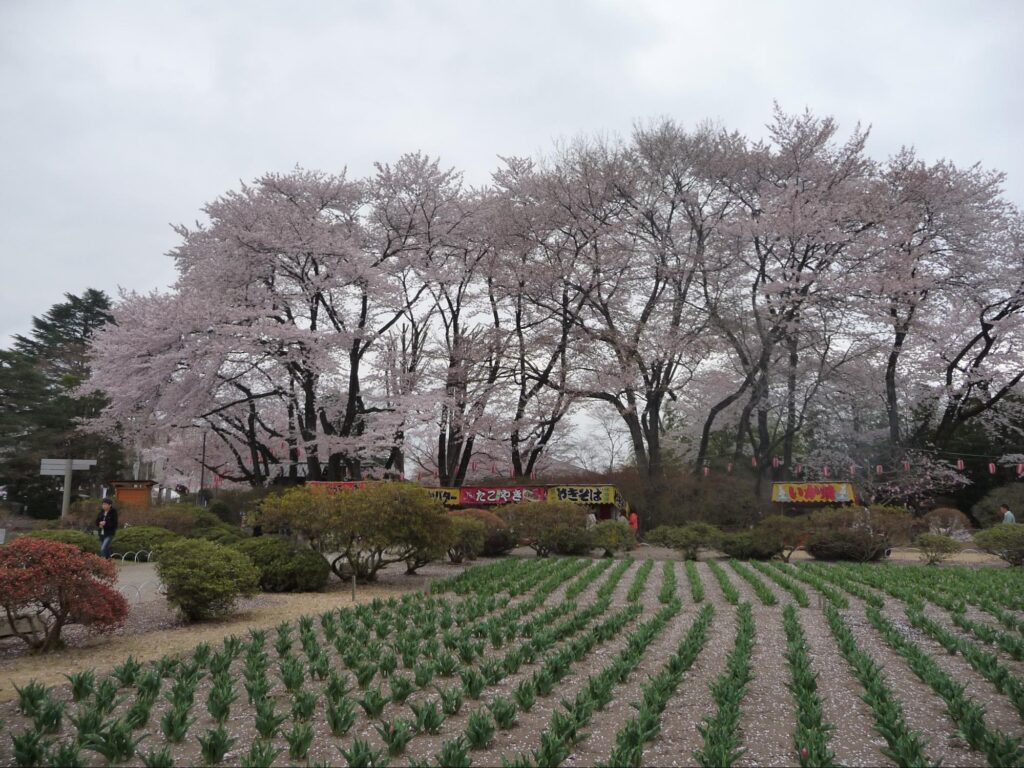This post was written in 2015, but most of the information is still applicable, no matter what sakura season it is!

What is hanami?
Hanami (also known by the formal ohanami, お花見) means “flower-viewing”, a popular activity to celebrate the arrival of spring throughout Japan. Traditionally, families and friends lay out tarps in their favourite viewing spot, break open some osake, and have a picnic beneath the trees. In particularly popular viewing spots, many people will arrive early in the day (even before heading to work in the morning) to reserve a place for their group; you’ll often see signs placed on top of tarps claiming space throughout parks.
How can I hanami in style?
For some of you, this will be your first hanami experience (mazeltov!). To get you started, here are a few tips for having a rad-tastic hanami.
- Secure your spot early, especially in the popular parks! The less time you have to spend wandering around looking for a spot to squeeze into, the more time you’ll have for flower-viewing and other merriment.
- Feel free to bring board games or playing cards to enjoy the milder weather. However, remember to be considerate of other park-goers. Gauge the park and your surroundings; maybe there are 57 families in your immediate area, which might not leave much space for a rowdy game of Ultimate Frisbee. Have fun, but be conscientious of others!
- Slap on some of that good ol’ SPF15 (or higher). For many of us, this will be the first time getting some proper sunlight this year, and with the spring sun growing stronger and the days growing longer, it’s best to make sure you’re well-protected.
- Be sure to bring plenty of water on top of any other food and drink for your picnic. This is especially true if you decide to have some booze with your hanami. Which brings me to…
- Public day-drinking is completely and wonderfully legal in Japan, and you’ll see many groups sharing nihonshu, wine, or a few Kirin premiums. If you do choose to partake, please be sure you have a safe way to get home before boozing. Drinking and driving is absolutely NOT tolerated, even if you feel sober enough to drive after drinking. Get a cab, call for a daiko (like a taxi driver who drives your car for you), assign a DD (Designated & 100% sober Driver), take public transit, or walk. Stay safe out there, friends!
- You may have noticed Japan is rather lacking in garbage bins in public spaces. Some parks may have a garbage and recycling site set up during hanami season, however others may not. Be ready to mochikaeri (take home) any trash you have, and be sure to clean up your picnic area before leaving.

When is this all taking place?
This year, the sakura should be reaching their peak around April 1st in Maebashi. However, cooler climates, higher elevations, and different varieties of sakura mean different blooming times, some as late as May. Once bloomed, though, the flowers don’t last very long — there’s usually about a two-week window for the best viewing, weather permitting. Check the weather forecast closer to the date to ensure you get to see the blossoms looking their best. (My personal favourite weather site in Japan is Tenki.jp, though you can also check the Japan Meteorological Agency website or the Japan National Tourism Organisation website for weather advisories and information in English.)
Sounds fab! Where should we go?
Sakura trees can be found just about everywhere: lining schoolyards, near train stations, and surrounding shrines and temples. Ask coworkers and friends, and keep an eye out in your own neighbourhoods for blossoming trees — chances are, there’ll be a few hidden-away sakura trees eager for an audience come April!

Takasaki Castle Ruins & Takasaki Park | 高崎城址公園・高崎公園

Maebashi Park | 前橋公園

Maebashi Park has more than 200 sakura trees and plenty of space for celebrating the beginning of spring. The park is a short walk away from the Prefectural Office, about a 30 to 35-minute walk from Maebashi and Shin-Maebashi Stations, or about a 20-minute walk from Chuo-Maebashi Station. There are several buses which pass by the park from all three stations as well. Look for buses which go via 県庁 (Kencho). Once onboard, you can get off at 県庁前 (Kencho-mae), 前橋公園 (Maebashi Kouen), or 前橋公園前 (Maebashi Kouen-mae) bus stops. There are also a couple of free parking lots available north of the park (towards the Maebashi Green Dome), so you have plenty of options for transportation!
Shikishima Park, Maebashi | 前橋市敷島公園

If you’re looking for a romcom-worthy date spot (lots of schmaltz!), Shikishima Park is just the place! The park has a quaint lake where you can feed ducks and board paddle boats with your platonic or romantic other. Though not as accessible by transit (it’s 4km away from the nearest stations), there’s plenty of free parking at Shoda Shoyu Stadium nearby. From Maebashi Station, you can also board a bus heading toward 敷島公園 (Shikishima Kouen). There are several stops for the park, including 敷島公園バスターミナル (Shikishima Kouen Bus Terminal), 競技場入口 (Kyougijou Iriguchi), and 敷島公園北口 (Shikishima Kouen Kita Guchi).
Kezouji Park, Isesaki | 伊勢崎市華蔵寺公園

Speaking of cheesy date spots, Isesaki’s Kezouji Park is a great place to take your sweetheart. Feel free to bring the kids along as well! There are nearly 1000 trees around the amusement park, which has 13 different attractions including a mini-roller coaster, bicycle monorail, and ferris wheel. There’s also a lot of open space for having a hanami adjacent to the amusement park. Parking is free, and buses leave from Isesaki Station (just looks for the buses labelled あおぞら [Aozora] or 赤堀シャトルバス [Akahori Shuttle Bus], and get off at 華蔵寺公園 [Kezoji Koen]).
Suidoyama Park, Kiryu | 桐生市水道山公園

Overlooking the city, Suidoyama Park is a scenic and conveniently-located place for having a hanami in Kiryu. Only about a kilometer away (about 20 minutes walking) from either Nishikiryu Station or the JR Kiryu Station, and with about 400 sakura trees, it’s a good spot for a quick getaway from the city. Set up your picnic on the slopes beneath the cherry blossom trees for a view into the city. Parking is also available, but limited, so taking the train is probably your best bet.
Akagi South Senbonzakura Park, Maebashi | 赤城南面千本桜

This park is one of the biggest for sakura festivals and hanami, with more than 1000 trees. It was also recently named one of the 100 best places for sakura in Japan. The trees line the walking path, creating a 2-kilometer long tunnel of blossoms. This year, the annual sakura festival will be held from April 4th to 19th. During this time, the trees will also be lit in the evenings until 9:30 p.m., with regular events occurring over this period, the largest of which is the Festa on April 18th (Saturday). Pay parking is available at the park, though buses will also be going to and from Maebashi Station and Akagi Station while the festival is on.
Numata Park and Numata Castle Ruins, Numata | 沼田市沼田城跡公園

Head up north to see the sakura in bloom at Numata Park. There are over 250 sakura trees surrounding the old site of Numata Castle, including 400-year-old weeping sakura tree known as gotensakura (“palace sakura”). The sakura should be in bloom in the first couple weeks of April, with the trees lit up in the evenings from 6–10 p.m. Other events and festival details have yet to be announced, but are planned for mid-April. The park can be accessed by car (free parking) or by bus from Numata Station (the distance from the station to the park is walkable, but is a very steep uphill climb).
Sakura no Sato, Mt Myogi | 妙義山さくらの里

One of the Three Jomo Mountains (上毛三山), Mt Myogi in Shimonita is an exceptional place for a stroll amongst the cherry trees. While it lacks open areas for hanami, Sakura no Sato is a beautiful place to enjoy flowers of all kinds this spring. The cooler weather here also means the blossoms come out much later than Maebashi. There are over 5000 trees and 45 different species of sakura here, some with much later blooming times than others. As a result, the flowers can be viewed from April through mid-May. You’ll need a car (or a willing friend with a car) to access the park, but it’s worth the drive! Click here for a map to the park.

Obata Castle Town Sakura Festival and Warrior Parade, Kanra | 甘楽町城下町小幡さくら祭り

Every year, the residents of Obata Castle Town relive the good ol’ days of yore with a street procession of warriors, samurai, courtesans, and other badass players of the past. You might even see the familiar faces of other Gunma ALTs taking part in the parade! This year, the festival will be held on April 5th. Follow the warriors’ parade through the sakura-lined streets of this old castle town, or branch off along the creeks to enjoy all the colours of spring! Going by car is highly recommended as there is ample free parking and buses are scarce (if at all). A map of the parade route and festival area can be found here.


This is only a small sample of the parks and places you can enjoy the sakura this spring. There are dozens more in Gunma alone! You can find a very comprehensive list of parks in Gunma on Gunma-Navi (in Japanese) and on the GTIA website (in English). For a list of sakura festivals around Gunma, check out the Visit Gunma webpage for information in English.
What’s your favourite hanami or sakura spot in Gunma? Comment below with your osusume (recommendation)! Happy hanami-ing, friends!

